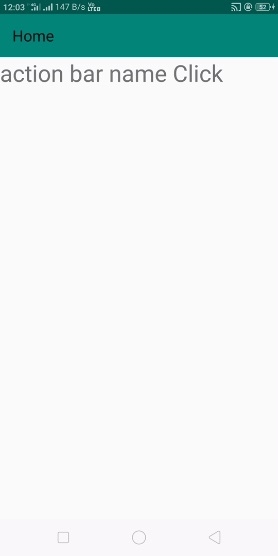
 Data Structure
Data Structure Networking
Networking RDBMS
RDBMS Operating System
Operating System Java
Java MS Excel
MS Excel iOS
iOS HTML
HTML CSS
CSS Android
Android Python
Python C Programming
C Programming C++
C++ C#
C# MongoDB
MongoDB MySQL
MySQL Javascript
Javascript PHP
PHP
- Selected Reading
- UPSC IAS Exams Notes
- Developer's Best Practices
- Questions and Answers
- Effective Resume Writing
- HR Interview Questions
- Computer Glossary
- Who is Who
How to Set OnClick Listener on Action Bar Title in Android?
This example demonstrates How to Set OnClick Listener on Action Bar Title in Android.
Step 1 − Create a new project in Android Studio, go to File ⇒ New Project and fill all required details to create a new project.
Step 2 − Add the following code to res/layout/activity_main.xml.
<?xml version = "1.0" encoding = "utf-8"?> <LinearLayout xmlns:android = "http://schemas.android.com/apk/res/android" xmlns:app = "http://schemas.android.com/apk/res-auto" xmlns:tools = "http://schemas.android.com/tools" android:layout_width = "match_parent" android:gravity = "center" android:layout_height = "match_parent" tools:context = ".MainActivity" android:orientation = "vertical"> <android.support.v7.widget.Toolbar android:id = "@+id/my_awesome_toolbar" android:layout_width = "match_parent" android:layout_height = "wrap_content" android:background = "@color/colorPrimary" android:minHeight = "?attr/actionBarSize" > <TextView android:id = "@+id/toolbarTitle" style = "@style/TextAppearance.Widget.AppCompat.Toolbar.Title" android:background = "?attr/selectableItemBackground" android:layout_width = "wrap_content" android:gravity = "center_vertical" android:layout_height = "match_parent" /> </android.support.v7.widget.Toolbar> <TextView android:id = "@+id/text" android:textSize = "30sp" android:layout_width = "match_parent" android:layout_height = "match_parent" /> </LinearLayout>
In the above code, we have taken toolbar and text view.
Step 3 − Add the following code to src/MainActivity.java
package com.example.myapplication;
import android.annotation.SuppressLint;
import android.app.ActivityManager;
import android.app.admin.DevicePolicyManager;
import android.content.ComponentName;
import android.content.Context;
import android.content.Intent;
import android.net.wifi.WifiInfo;
import android.net.wifi.WifiManager;
import android.os.Build;
import android.os.Bundle;
import android.support.annotation.RequiresApi;
import android.support.v7.app.AppCompatActivity;
import android.view.MenuItem;
import android.view.View;
import android.widget.TextView;
import android.widget.Toolbar;
public class MainActivity extends AppCompatActivity {
TextView textView;
@SuppressLint("RestrictedApi")
@RequiresApi(api = Build.VERSION_CODES.N)
@Override
protected void onCreate(Bundle savedInstanceState) {
super.onCreate(savedInstanceState);
getSupportActionBar().hide();
setContentView(R.layout.activity_main);
setSupportActionBar((Toolbar) findViewById(R.id.toolbar));
TextView toolbarTitle = (TextView) findViewById(R.id.toolbarTitle);
toolbarTitle.setText("Home");
toolbarTitle.setOnClickListener(new View.OnClickListener() {
@Override
public void onClick(View v) {
finish();
}
});
textView = findViewById(R.id.text);
textView.setText("action bar name Click ");
}
private void setSupportActionBar(Toolbar toolbar) { }
}
Let's try to run your application. I assume you have connected your actual Android Mobile device with your computer. To run the app from android studio, open one of your project's activity files and click Run ![]() icon from the toolbar. Select your mobile device as an option and then check your mobile device which will display your default screen –
icon from the toolbar. Select your mobile device as an option and then check your mobile device which will display your default screen –

Click here to download the project code

